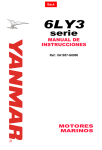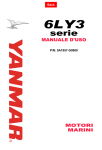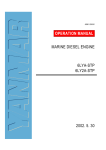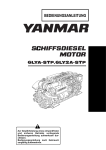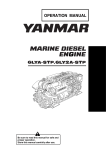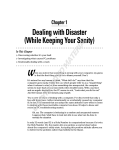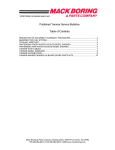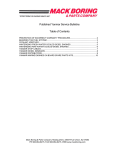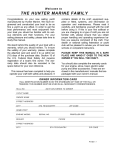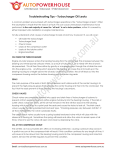Download Diesel Diagnosis
Transcript
We attend Mack Boring’s diesel school to learn to treat common engine problems. By 48 j u l y/a u g u s t 2 0 1 3 m photo: zach stovall L arry Berlin is a nice guy, but you don’t want to spend time with him on your boat. Because if he’s poking around your engine room, there’s something wrong. Berlin is the resident “Diesel Doctor” for Mack Boring in New Jersey, one of the largest marine diesel distributors in the United States. Berlin instructs its technicians and also teaches a class for boaters. I attended to learn how to avoid him. Why? He once drove six billable hours to help a boater whose engine had shut down. The problem? A 10-cent rubber O-ring the boater forgot to install with his oil filter. That mistake turned into a four-digit bill. So, under Berlin’s tutelage, I learned the four key aspects of marine engines: lubrication, cooling, electricity and fuel. 49 Other students in the class own different styles of boats, from an MJM 34 propelled by a Yanmar 6LY3, to a Viking 42 powered with twin Cummins diesels mated to Zeus pod drives, to a Mainship 34 with a Yanmar 6LYA. But all came for the same reason: to understand their engines. Berlin stands in front of all of us, starting the class with this maxim: “These aren’t cars.” He adds, “On a planing boat you’re climbing Pike’s Peak all day long because the water’s always trying to stop you.” And then, “Guys who don’t believe in preventive maintenance are not going to get away with it.” The first, most important component to maintain is the engine’s lubrication system: the oil. Oil not only reduces friction in moving parts, but it — not the cooling system — is also most responsible for keeping the pistons and cylinders cool. Oil also acts as a seal for cylinder walls, valve stems and the turbochargers, keeping contaminants and corrosion at bay. Fortunately, the lubrication system is easy to maintain: Change the oil based on engine hours or seasonally, and change the filters at the same time. Changing the oil every fall during winterization is critical, Berlin says, because old oil becomes acidic and will corrode the inside of your engine. Berlin walks behind the classroom tables to an old engine block and pulls out the dipstick: It needs to be checked before every trip. “You’re only checking whether it’s full enough,” he tells us. “Oil color doesn’t determine your oil life; only engine hours do.” The first service point is the oil filter. Change it according to your owner’s manual and be sure to change all the gaskets and seals too. A common problem Berlin sees is buying the wrong filter for the engine, which could harm it by restricting flow. Berlin holds up a circular piece of rubber that looks like it’s been assaulted by a weed whacker. It’s a rawwater pump impeller gone bad. Impeller failure is another problem that gets him into the field on an hourly rate. A healthy pump impeller looks like a gear, with rubbery veins that spin and flex as the pump does its work. Impellers absorb seawater over time and harden, causing the veins to warp, bend or break off. Once its veins bend or harden, it will never pump the full amount of water your engine needs. Berlin suggests it’s best to remove the impeller in Besides the oil and filter, follow the oil line’s route from the reservoir to the engine. Look for external signs of damage or rust; corrosion can lead to leaks that can cause an engine to seize in a heartbeat. While maintaining the oil is easy, the oil system typically has the least amount of warning — usually just an “idiot” light if the oil pressure drops below 7 psi. So don’t wait for symptoms if you want to keep Berlin out of your engine room. Room Temperature (Cooling) One of the biggest culprits in engine problems isn’t, technically, a part of the engine. At least not one covered by warranty. Berlin says this: “Clogged sea strainers are the number one cause of failed engines.” Fouled strainers prevent raw water from cooling the 50 j u l y/a u g u s t 2 0 1 3 13 fresh water, which throws off the whole system. A marine engine’s cooling system consists of two basic components. The raw-water system draws in seawater through an open seacock via an in-line pump. The seawater goes through a lube oil cooler and then to a heat exchanger, where it cools the engine’s fresh water. It then runs through the mixing elbow, where it cools the 1,300-degree F exhaust gas before exiting via the exhaust system. The freshwater system is a closed loop that pumps water from the reserve tank to the cylinder jacket, turbocharger and cycle head. After start-up, a thermostat in the system regulates a valve that cycles the heated water through a heat exchanger, where it is cooled by the seawater. Discussing this in the classroom, Diesel 911 The 10 most common problems found in engine service calls: Water, growth or sludge in the fuel QUICK TIP Don’t use auto engine belts; they can’t survive in a marine engine room. Clogged sea strainers Damaged impellers Old antifreeze the fall and put in a new one every spring, but at the very least take it out. Removing the raw-water pump requires a socket wrench to take the pump off the block and an impeller removal tool, which is kind of like a wine rabbit, to pull it from the housing. (You can buy an impeller remover for $100 to $150 from your marine supply store.) Before you put the new one in, coat the inside of the pump with the provided glycerin or extra virgin olive oil. Putting the pump back in place requires more thought than removing it. Every bolt on the engine — indeed, every hose clamp — has a specific torque spec and tightening sequence. Look through your engine’s service manual to follow the specified tightening pattern, and use a torque wrench to tighten it to those specs. On the freshwater system, the easiest thing to maintain is the pressure cap. It needs to be properly sealed so that it increases the pressure enough to raise the boiling point of water from 212 degrees F to 250. Otherwise the water in your engine will boil and your system will overheat. Look for a bent cap — they often get stepped on in the engine room — or a faulty seal. Also, change the antifreeze every two years, using only an extended- QUICK TIP To check your thermostat, run thread through the valve and boil it in water until it opens. Loose belts Plugged mufflers Clogged fuel filters photos: robert yasKovic Oil and Water (Lubrication) Loose alternators Corroded electrical connections Blown fuses 51 QUICK TIP When working with a socket wrench, put a piece of paper towel in the socket to hold the bolt in place, so it won’t fall into the bilge. Diesel Academy Mack Boring offers a basic one-day seminar and a three-day comprehensive course in diesel-engine maintenance. For more information, contact 908-964-0700 or mackboring.com. 52 j u l y/a u g u s t 2 0 1 3 controlled engines, it’s not to be touched by us at all. Moving on to something more our speed, Berlin holds up an old mixing elbow, the macaroni-shaped part that funnels exhaust and seawater from the engine. He instructs us to look inside — it is nearly completely blocked with scaling and corrosion. “These need to be changed every three years,” he says, “but nobody ever does it. Then they call us.” On the freshwater side, a part to keep an eye on is the thermostat. It opens and closes anywhere from 100 to 1,000 times a minute to regulate coolant flow. Though incredibly reliable, these do eventually break down. Berlin shows us how to do a field test. Remove it from the engine and run a thread through the release valve. Hold the top of the thread and drop it in water and boil it until it falls off the string. Then measure the water temperature that opened the valve and the length of the opening hole. If not up to spec, replace it. Don’t Do It Yourself What not to touch during engine maintenance Valve Adjustments All diesel engines require periodic valve adjustments. Mack Boring teaches boaters how to do this if they want, but it’s a very technical hands-on job, and if done wrong, it can have disastrous consequences. Best to leave it to the pros. Retorquing Cylinder Heads Your engine’s cylinder heads need to be retorqued after so many hours of operation (see your manual). But it has to be done to exact specifications or else it will harm the engine. Another situation where it pays to pay the pros. Fire It Up (ElectricITY) An engine’s DC electrical system is another common point of issue, but usually the least threatening. That is, if the electrical system shuts down the engine won’t overheat; it just won’t start or run. On the other hand, if it won’t start and you’re stuck adrift or at anchor 100 miles from the nearest port, that’s kind of a big deal. “Loose or dirty connections are a huge problem in DC systems,” Berlin says, “but nobody ever checks them either.” The cable from the battery to the starter motor is critical, so check those connections first. Also check the wires to the oil pressure switch, the cooling water Turbochargers These require very particular service specifications and should be left to the shop. photos: robert yasKovic life brand (think pink not green), and mix it only with distilled water. Berlin shows us other, more complicated maintenance projects, such as removing the heat exchanger to send it out for cleaning. It needs to be done every three years. On most engines, the removal is a three-hour job involving disassembly of other parts and fittings. On commonrail and electronically ECM and CommonRail Diesels For electronically controlled and common-rail engines, stick to the basic service points and let a trained technician plug in his computer for the rest. temperature switch and the battery switch. ... Any wire involved in monitoring the engine needs to be monitored by you. Fuses are also culprits. Also check the starter motor for a bad solenoid or a bad Bendix drive. Berlin points to the alternator as another source of concern. “A guy called because his batteries weren’t charging,” Berlin says. “And it turned out his alternator had worked loose from his engine.” Check that the bolts holding the alternator in place are properly torqued. Equally important, check that the belts are both the right size and type for your engine and also that they are tightened. This goes for all the belts on the engine, which can cause the engine to overheat if they’re too loose. When changing belts, a simple belt-tension jack ($20, mscdirect.com) set between the pulleys can make sure they’re tight. Burn, Baby, Burn (Fuel) Berlin looks out at us from the front of the classroom and says, matterof-factly, “The United States has the worst quality diesel fuel of any industrialized nation.” Not surprisingly, this leads to a lot of calls for Berlin and the crew at Mack Boring to head out into the field. Outside of keeping your tank full to prevent microbial growth, there’s not a lot QUICK TIP Taking something apart? Snap step-bystep photos with your cell phone. you can do about the fuel itself. But on the engine, the fuel filter is the first line of defense. Buy the specified one for the engine and check the inspection bowl before every trip. If you see water, drain it and run it again. If water shows up a second time, you’ve got bad fuel. A diesel owner needs to know how to bleed the fuel system if air gets into it and shuts down the engine. Loosen the screw on the filter to pop up the hand pump and keep pumping until only diesel fuel comes out. If that doesn’t work, vent the fuel-injection piping from the fuel line using a 17 mm fuel line wrench. If you spill diesel in the bilge, Berlin suggests Dawn dishwashing liquid is the only thing that will get rid of the smell. Yet another tip in a long list of prescriptions from the Diesel Doctor: Take the class, and maybe you won’t have to pay him for a house call. 53



